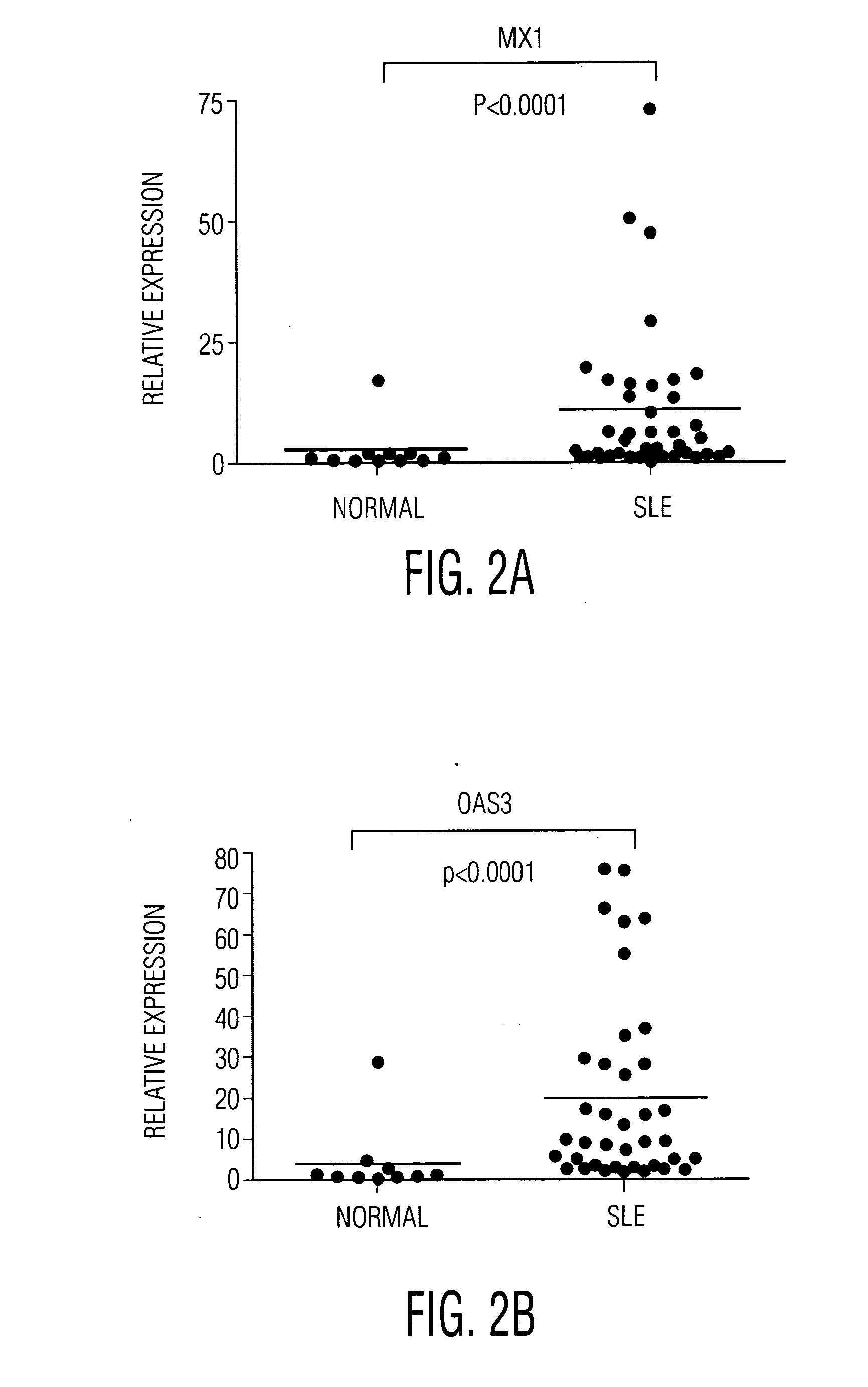Compounds and methods for treating or preventing autoimmune diseases
a technology for autoimmune diseases and compounds, applied in the field of compounds and methods for treating or preventing auto, can solve the problems of destroying both, affecting the survival rate of autoimmune diseases, and affecting the survival rate of autoimmune diseases, and destroying both
- Summary
- Abstract
- Description
- Claims
- Application Information
AI Technical Summary
Benefits of technology
Problems solved by technology
Method used
Image
Examples
example 1
[0080]Human U133A microarrays (Affymetrix Inc. Santa Clara, Calif.) were used to profile transcriptional changes in THP-1 cells stimulated with cytokines. THP-1 cells seeded at 5×105 cells / ml were treated with 100 IU / ml IFN-α, 10 ng / ml IFN-α, 10 ng / ml TNF-α, or vehicle control for four hours. Total RNA was isolated in Trizol reagent (Invitrogen Inc, Carlsbad, Calif.) and purified on RNeasy plate (Qiagen Inc, Valencia, Calif.). The purified total RNA from eight biological replicates for IFN-α and IFN-γ treatments, six replicates of TNFα treatments, and 14 replicates of vehicle only controls were processed and hybridized on HT_HG-U133A high-throughput 96 well array plates according to Affymetrix High-Throughput Array platform protocols provided by the microarray supplier. The raw data files were processed and normalized with RMA express. All the stimulated gene expression data sets were normalized to the vehicle control treatments for the pathway gene marker se...
example 2
Dose Dependent Gene Transcriptional Inhibition (TI)
[0086]2.4×104 THP-1 cells were seeded in 384 well culture plate in 30 μl culture medium. Test compounds in 100% DMSO were diluted and yielded final concentrations from 10 μM to 5 nM in the cell culture directly. Cells were treated with test compounds together with 100 IU / ml IFN-α for 4 hours before they were lysed for RNA isolation. The IFN-α markers were profiled with the purified RNA using the HITS assay. The IFN-α signature genes were normalized to the GAPDH control, and subsequently the median mRNA level for each of the seven genes was calculated. The dose dependent gene transcriptional inhibition curves were then generated for each of the test compounds. Results are shown in FIG. 3.
example 3
Human PBMC Stimulation with IFN-α or Patient Serum
[0087]SLE patient and control serum were purchased from Bioreclamation (Hicksville, N.Y.). IFN-α 2a was obtained from PBL Biomedical laboratories (Piscataway, N.J.). Fresh PBMCs from healthy donor were prepared by Ficoll-hypaque fraction according to the manufactory's instruction. Cells were cultured at 2×105 cells / 0.1 ml in 96-well flat-bottomed plates in culture medium.
[0088]To determine the effect of compounds on gene expression, compounds and vehicle controls were pre-incubated with cells for 30 min at 37° C. before stimulation with 50% lupus serum or 100 IU / ml IFN-α 2a were incubated with PBMC. After 6 h stimulation, cells were lysed in Qiagen 2XTCL lysis buffer followed by HITS analysis (see FIG. 2).
PUM
| Property | Measurement | Unit |
|---|---|---|
| conducting | aaaaa | aaaaa |
| cross-reactivity | aaaaa | aaaaa |
| chemical genomics | aaaaa | aaaaa |
Abstract
Description
Claims
Application Information
 Login to View More
Login to View More - R&D
- Intellectual Property
- Life Sciences
- Materials
- Tech Scout
- Unparalleled Data Quality
- Higher Quality Content
- 60% Fewer Hallucinations
Browse by: Latest US Patents, China's latest patents, Technical Efficacy Thesaurus, Application Domain, Technology Topic, Popular Technical Reports.
© 2025 PatSnap. All rights reserved.Legal|Privacy policy|Modern Slavery Act Transparency Statement|Sitemap|About US| Contact US: help@patsnap.com



